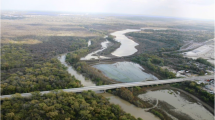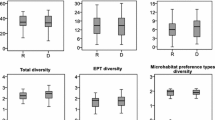Abstract
The sequence of colonization, species diversity (% MathType!MTEF!2!1!+-% feaafiart1ev1aaatCvAUfeBSjuyZL2yd9gzLbvyNv2CaerbuLwBLn% hiov2DGi1BTfMBaeXatLxBI9gBaerbd9wDYLwzYbItLDharqqtubsr% 4rNCHbGeaGqiVu0Je9sqqrpepC0xbbL8F4rqqrFfpeea0xe9Lq-Jc9% vqaqpepm0xbba9pwe9Q8fs0-yqaqpepae9pg0FirpepeKkFr0xfr-x% fr-xb9adbaqaaeGaciGaaiaabeqaamaabaabaaGcbaWaa0aaaeaaca% qGKbaaaaaa!36E5!\[\overline {\text{d}} \]), biomass, and productivity of macroinvertebrates on artificial substrates was determined in a relatively constant environment freshwater canal. Three substrates were removed weekly during a 16 week test period. Community structure of benthic macroinvertebrates was determined at the onset and end of the test period and compared with substrate community structure.
Calopsectra sp. was the dominant early colonizing organism; Dicrotendipes sp. and Dicrotendipes modestus were also abundant. In late collections other chironomids, ephemeropterans, gastropods, oligochaetes, amphipods, and trichopterans occurred. Trichopterans were generally dominant in numbers and biomass in later collections. A total of 104 were collected on the substrates.
Collection diversity (% MathType!MTEF!2!1!+-% feaafiart1ev1aaatCvAUfeBSjuyZL2yd9gzLbvyNv2CaerbuLwBLn% hiov2DGi1BTfMBaeXatLxBI9gBaerbd9wDYLwzYbItLDharqqtubsr% 4rNCHbGeaGqiVu0Je9sqqrpepC0xbbL8F4rqqrFfpeea0xe9Lq-Jc9% vqaqpepm0xbba9pwe9Q8fs0-yqaqpepae9pg0FirpepeKkFr0xfr-x% fr-xb9adbaqaaeGaciGaaiaabeqaamaabaabaaGcbaWaa0aaaeaaca% qGKbaaaaaa!36E5!\[\overline {\text{d}} \]) began at 3.42 (week 1), decreased to 2.72 in the third week, and then continually increased for the remainder of the test period to 4.43. Cumulative diversity had a similar trend, decreasing from 3.42 (week 1) to 3.06 in the fourth week, and then increasing to 4.05. Neither collection % MathType!MTEF!2!1!+-% feaafiart1ev1aaatCvAUfeBSjuyZL2yd9gzLbvyNv2CaerbuLwBLn% hiov2DGi1BTfMBaeXatLxBI9gBaerbd9wDYLwzYbItLDharqqtubsr% 4rNCHbGeaGqiVu0Je9sqqrpepC0xbbL8F4rqqrFfpeea0xe9Lq-Jc9% vqaqpepm0xbba9pwe9Q8fs0-yqaqpepae9pg0FirpepeKkFr0xfr-x% fr-xb9adbaqaaeGaciGaaiaabeqaamaabaabaaGcbaWaa0aaaeaaca% qGKbaaaaaa!36E5!\[\overline {\text{d}} \] or cumulative % MathType!MTEF!2!1!+-% feaafiart1ev1aaatCvAUfeBSjuyZL2yd9gzLbvyNv2CaerbuLwBLn% hiov2DGi1BTfMBaeXatLxBI9gBaerbd9wDYLwzYbItLDharqqtubsr% 4rNCHbGeaGqiVu0Je9sqqrpepC0xbbL8F4rqqrFfpeea0xe9Lq-Jc9% vqaqpepm0xbba9pwe9Q8fs0-yqaqpepae9pg0FirpepeKkFr0xfr-x% fr-xb9adbaqaaeGaciGaaiaabeqaamaabaabaaGcbaWaa0aaaeaaca% qGKbaaaaaa!36E5!\[\overline {\text{d}} \] reached an asymptote in the 16 week period.
Collection biomass began at 0.0867 g/0.26 m2 for week one and was 1.0575 g/0.26 m2 at the end of the test period. Biomass increased linearly for seven weeks, fluctuated widely until week 14, then increased sharply for the remainder of the test period. Productivity ranged from −3.42 g/m2/wk in the eighth week to 5.10 g/m2/wk in the last collection. Biomass and productivity were greatly affected by the presences or absences of a relatively few large organisms.
One hundred two taxa were collected from the benthic samples, 34 not being present on the substrates. Limodrilus hoffmeisteri was the dominant benthic organism, while Calopsectra sp. and Polypedilum sp. were also abundant. The February benthic diversity % MathType!MTEF!2!1!+-% feaafiart1ev1aaatCvAUfeBSjuyZL2yd9gzLbvyNv2CaerbuLwBLn% hiov2DGi1BTfMBaeXatLxBI9gBaerbd9wDYLwzYbItLDharqqtubsr% 4rNCHbGeaGqiVu0Je9sqqrpepC0xbbL8F4rqqrFfpeea0xe9Lq-Jc9% vqaqpepm0xbba9pwe9Q8fs0-yqaqpepae9pg0FirpepeKkFr0xfr-x% fr-xb9adbaqaaeGaciGaaiaabeqaamaabaabaaGcbaWaa0aaaeaaca% qGKbaaaaaa!36E5!\[\overline {\text{d}} \] was 4.54 and the June % MathType!MTEF!2!1!+-% feaafiart1ev1aaatCvAUfeBSjuyZL2yd9gzLbvyNv2CaerbuLwBLn% hiov2DGi1BTfMBaeXatLxBI9gBaerbd9wDYLwzYbItLDharqqtubsr% 4rNCHbGeaGqiVu0Je9sqqrpepC0xbbL8F4rqqrFfpeea0xe9Lq-Jc9% vqaqpepm0xbba9pwe9Q8fs0-yqaqpepae9pg0FirpepeKkFr0xfr-x% fr-xb9adbaqaaeGaciGaaiaabeqaamaabaabaaGcbaWaa0aaaeaaca% qGKbaaaaaa!36E5!\[\overline {\text{d}} \] was 4.05.
Similar content being viewed by others
References
American Public Health Association. 1975. Standard Methods for the Examination of Water and Waste Water, 14th ed. Amer. Publ. Health Assoc. New York. 1193 pp.
Anderson, J. B. & Mason, W. T. 1968. A comparison of benthic macroinvertebrates collected by dredge and basket sampler. JWPCF 40: 252–259.
Arthur, J. W. & Horning, W. B. 1969. Use of artificial substrates in pollution surveys. Amer. Midl. Nat. 82: 83–99.
Beak, T. W., Griffing, T. C. & Appleby, A. G. 1973. Use of artificial substrate samplers to assess water pollution. In: Biological Methods for the Assessment of Water Quality (Cairns and Dickson, ed.) American Society for Testing and Materials: 227–241.
Bishop, J. E. & Hynes, H. B. N. 1969. Upstream movements of the benthic invertebrates in the Speed River, Ontario. J. Fish. Res. Bd. Canada 26: 279–298.
Bull, C. J. 1968. A bottom fauna sample for use in stony streams. Prog. Fish Cult. 30: 119–120.
Cooke, W. B. 1956. Colonization of artificial bare areas by micro-organisms. Bot. Rev. 22: 613–638.
Dickson, K. L. & Cairns, J. 1972. The relationship of freshwater macroinvertebrate communities collected by floating artificial substrates to the MacArthur-Wilson Equilibrium model. Amer. Midl. Nat. 88: 68–75.
Dickson, K. L., Cairns, J. & Arnold, J. C. 1971. An evaluation of the use of a basket-type artificial substrate for sampling macroinvertebrate organisms. Trans. Amer. Fish. Soc. 100: 553–559.
Elliot, J. M. & Minshall, G. W. 1968. The invertebrate drift in the River Duddon, English Lake District. Oikos 19: 39–52.
Environmental Protection Agency. 1973. Biological field and laboratory methods for measuring the quality of surface waters and effluents. Environmental Protection Agency, Cincinnati, Ohio. EPA-67014-73-001. 38 pp.
Fullner, R. W. 1971. A comparison of macroinvertebrates collected by basket and modified multiple-plate samplers. JWPCF 43: 494–499.
Glime, J. M. & Clemons, R. M. 1972. Species diversity of stream insects on Fontinalis spp. compared to diversity on artificial substrates. Ecology 53: 458–463.
Harrel, R. C. & Dorris, T. C. 1968. Stream order, morphometry, physico-chemical conditions, and community structure of benthic macroinvertebrates in an intermittent stream system. Amer. Midl. Nat. 80: 220–251.
Henson, E. B. 1965. A cage sampler for collecting aquatic fauna. Turtox News 43: 298–299.
Hester, F. E. & Dendy, J. S. 1962. A multiple sampler for aquatic macroinvertebrates. Trans. Amer. Fish. Soc. 91: 420–421.
Hilsenhoff, W. L. 1969. An artificial substrate device for sampling benthic stream invertebrates. Limnol. Oceanogr. 14: 465–471.
Hynes, H. B. N. & Coleman, M. J. 1968. A simple method of assessing the annual production of stream benthos. Limnol. Oceanogr. 13: 569–573.
Jacobi, G. Z. 1971. A quantitative artificial substrate sampler for benthic macroinvertebrates. Trans. Amer. Fish. Soc. 100: 136–138.
Margalef, R. 1958. Temporal succession and spatial heterogeneity in phytoplankton. Perspectives in Mar. Bio.: 323–349.
Mason, W. T., Anderson, J. B., Kreis, R. D. & Johnson, W. C.. 1970. Artificial substrate sampling, macroinvertebrates in a polluted reach of Klamath River, Oregon. JWPCF 42: R315-R328.
Mason, W. T., Anderson, J. B. & Morrison, G. E. 1967. A limestone filled, artificial substrate sampler-float unit for collecting macroinvertebrates in large streams. Prog. Fish Cult. 29: 74.
Mason, W. T., Weber, C., Lewis, P. & Julian, E. 1973. Factors affecting the performance of basket and multiplate macroinvertebrate samplers. Freshwat. Biol. 3: 409–436.
Mason, W. T. & Yevich, P. P. 1967. The use of phloxine B and rose bengal stains to facilitate sorting benthic samples. Trans. Amer. Micro. Soc. 86: 221–223.
Mundie, J. H. 1956. A bottom sampler for inclined rock surfaces in lakes. J. of Anim. Ecol. 25: 429–432.
Odum, E. P. 1971. Fundamentals of Ecology. 3rd ed. W. B. Saunders Co. Philadelphia. 573 pp.
Parsons, D. S. & Tatum, J. 1974. A new shallow water multiple-plate sampler. Prog. Fish Cult. 36: 179–180.
Patten, B. C. 1962. Species diversity in net phytoplankton of Raritan Bay. J. Mar. Res. 20: 57–75.
Pennak, R. W. 1953. Freshwater Invertebrates of the United States, 1st ed. Ronald Press Co. New York. 769 pp.
Sladecek, V. & Sladeckova, A. 1963. Relationship between wet weight and dry weight of the periphyton. Limnol. Oceanogr. 8: 309–311.
Sladeckkova, A. 1962. Limnological investigation methods for the periphyton (‘aufwuchs’) community. Bot. Rev. 28: 286–350.
Waters, T. F. 1962. A method to estimate the production rate of a stream bottom invertebrate. Trans. Amer. Fish. Soc. 91: 243–250.
Waters, T. F. 1964. Recolonization of denuded stream bottom areas by drift. Trans. Amer. Fish. Soc. 93: 311–315.
Wilhm, J. L. 1967. Comparison of some diversity indices applied to populations of benthic macroinvertebrates in a stream receiving organic wastes. JWPCF 39: 1673–1682.
Wilhm, J. L. & Dorris, T. C. 1968. Species diversity of benthic macroinvertebrates in a stream receiving domestic and oil refinery effluents. Amer. Midl. Nat. 76: 427–449.
Williams, D. D. & Hynes, H. B. N. 1976. The recolonization mechanisms of a stream benthos. Oikos 27: 265–272.
Author information
Authors and Affiliations
Rights and permissions
About this article
Cite this article
Cover, E.C., Harrel, R.C. Sequences of colonization, diversity, biomass, and productivity of macroinvertebrates on artificial substrates in a freshwater canal. Hydrobiologia 59, 81–95 (1978). https://doi.org/10.1007/BF00017608
Received:
Issue Date:
DOI: https://doi.org/10.1007/BF00017608




